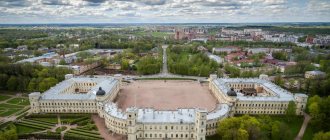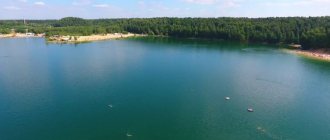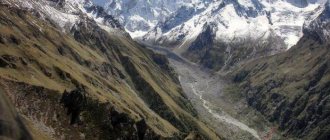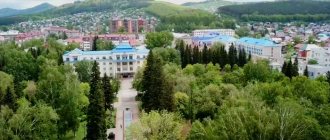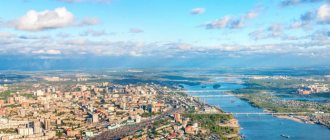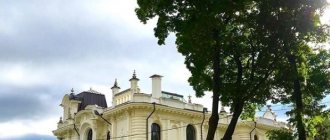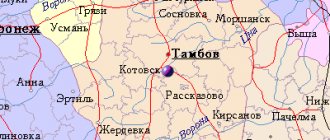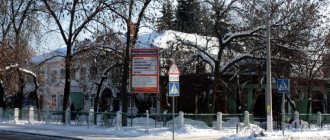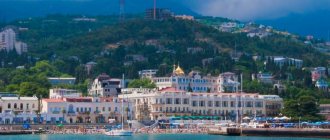Likino-Dulevo is a small town near Moscow, in the Orekhovo-Zuevsky district, in the east of the region. It is famous for its porcelain factory, bus factory and cultural palace.
Dulevo porcelain factory. The largest in Russia. Founded by famous industrialists Kuznetsov in 1832.
Likinsky bus plant. Everyone who lived in the USSR drove a LiAZ. Unfortunately, there is no museum at the car plant. The plant is now part of the GAZ group.
Palace of Culture of the Porcelain Factory. This is the only building of the constructivist architect Melnikov outside of Moscow.
Let's take a closer look at the city
Church of St. John the Evangelist (construction completed in 1917), architect Scherer.
There is a bell tower next to the temple. Young people master the profession of bell ringer.
Constructivist clinic. Built in 1934.
It seems that the city has changed little over the past half century.
Judging by the style of the posters, we are in 1987. How's DDT doing? "Indian tea, Bashkir honey."
Likino-Dulevo is generally a quiet and pretty town. People come here to buy dishes. This is one of the folk crafts.
Let's turn our attention to Dulevo porcelain
I wonder what the Likino-Dulevites wrote to their descendants in 1982?
Former factory owner.
The plant's trademark is a white falcon, although if you don't know, you might mistake it for a dove.
And this is what it looks like on the stamp. Black spots on the bottom indicate violations in the technical process, but the prices here are low.
In the company store you can buy dishes from the “Red Cross” series
Or a plate with cartoon characters. As a child, I had such a plate with the characters “Well, wait a minute!”
You can buy cups with a Suprematist design for 20 rubles. Hello Melnikov!
Or you can have a napkin holder for 9 rubles.
The choice is large.
Prices are low.
Although... But who needs a boy for 25,000 rubles?
But something tasteless costs some crazy money, I wonder who’s buying it?
The plant, which was once a supplier to the imperial court, slipped into the production of consumer goods. It is possible that interesting porcelain is kept in the factory museum. But the museum is not open on Sundays. Fortunately, the city museum has its own collection of Dulevo porcelain. There is even an opportunity to drink tea with a guide from Dulevo cups.
You can read background information about Dulevo on our website.
Views of the plant from Gagarin Street
There are also good views of the city from the swamp.
And a little to the side of the plant there are some ruins of the Soviet period
And a few more views of the plant from Kalinina Street
You can often see new buses near the plant, and if you’re lucky, you can be one of the first to see a new model.
The history of its origin goes back to 1933, when the decision was made to build the LOZOD Timber Chemical Pilot Plant for wood refining. In 1935, the plant produced: insulating boards, lignostone bars, pressed wood and products made from it. Since 1945, the plant became known as the Likinsky Machine-Building Plant (LiMZ) and produced: electric stoves, sleeper cutting machines, motor vehicles, winches, and mobile power plants. In 1946, the plant employed more than 1,100 people.
Since 1959, the plant begins assembling ZiL 158 passenger buses and becomes the Likino Bus Plant (LiAZ). The annual production amounted to 213 buses in 1959, 5419 units in 1963, 7045 units in 1969. At the same time, development and testing of a new, improved large city bus was underway. It became LiAZ-677. pilot batch, which was manufactured in 1967. Over 25 years, more than 200,000 LiAZ-677 buses and its modifications have been manufactured: city, northern, excursion, suburban, gas-cylinder, mobile television station. In the fall of 1972, the LiAZ-677 bus received a Gold Medal and a First Class Diploma at the international fair in Leipzig. In 1975, production was introduced to the designed capacity of 10,000 buses per year. In 1976, by Decree of the Presidium of the Supreme Soviet of the USSR, the plant was awarded the Order of the Red Banner of Labor. In 1982, development began on a project for the technical re-equipment of the LiAZ plant to produce LiAZ-5256 buses. In 1985, the start of technical re-equipment; At the same time, the production of buses in small batches began in the small series workshop. Serial production of large city buses LiAZ-5256 will begin in 1990.
From 1991 to 1995, the plant was characterized by a significant deterioration in performance indicators, which resulted in an economic crisis and a shutdown of production in 1996. A bankruptcy case was initiated and in 1997 external administration was introduced, then bankruptcy proceedings. However, the procedures were carried out in such a way that the territory, property of the bus plant, and its production activities were preserved and today Likinsky Bus LLC is a modern enterprise that has the technology for serial production of large city buses using advanced highly efficient technologies that ensure the production of products that meet current European standards. The territory of the enterprise is 630 thousand sq.m. Production area 172 thousand sq.m.
Since 2000, new models of city buses have been developed taking into account consumer demand and the production of city buses of extra large capacity LiAZ-6212 (articulated), suburban buses LiAZ-5256R has begun; Since 2005, mass production of low-floor city buses has been carried out. In 2000 he joined the Russian Buses company. Since 2005, it has been part of the GAZ automobile manufacturing group. In the 21st century, new bus models were developed and began to be produced: low-floor LiAZ-5292 and LiAZ-5293, articulated LiAZ-6212, and articulated and low-floor LiAZ-6213. trolleybuses LiAZ-5280, LiAZ-52802, LiAZ-52803 were developed on the basis of manufactured buses. On December 6, 2007, the plant produced the first trolleybus, entirely produced at the enterprise. It is planned that this line will produce 500 trolleybuses per year, with the subsequent possibility of increasing productivity to 1000 units per year.
In 2012, an overground pedestrian crossing was built near the plant (the only one in the Orekhovo-Zuevsky district), local residents immediately dubbed it a new landmark, although such a crossing is not unique, I saw exactly the same ones in Vyshny Volochyok
And several views from it: Kalinin Street
Sorry to repeat. Entrance gate of the LiAZ plant
street 30 let VLKSM, at the end of the street there is the MIR cinema
In April of this year, a new museum was opened in Likino-Dulyovo, which is dedicated to the Kudykino volost. Initially, they wanted to dedicate the museum to Kudykina Mountain, which is located only 2 kilometers from the museum, but then the creators of the museum decided to expand the theme to the Kudykino volost. In this museum you can learn both about Kudykina Mountain and the history of the city of Likino-Dulyovo, and here you can also learn about interesting places in the Orekhovo-Zuevsky district. ENTRANCE TO THE MUSEUM IS FREE!!!
The museum consists of 2 halls. The first contains antiques and old photographs.
The second hall houses the Soviet exposition.
There is also a stand in this hall that displays crafts made by children at master classes.
If you wish, you can buy a small souvenir here))
Museum address: Moscow region, Orekhovo-Zuevsky district, Likino-Dulyovo city, Kalinina street 3a. Opening hours: Mon-Fri from 10.00 to 16.00, Saturday and Sunday closed.
There are also interesting corners in the courtyards, for example, in the courtyard of house 7A on Kalinin Street there is a “propaganda site” preserved
And not far from this place (unfortunately it has not survived) near the bakery there was such an interesting nesting doll. By the way, this factory bakes the most excellent bread; there is a store at the factory;-)
In the city cemetery there is a monument to those who fell in the Great Patriotic War. In total, in this small town there are currently 5 monuments of military glory, 4 of which are publicly accessible, but according to my information, the local authorities want to remove 2 or 3 monuments; to replace them, a memorial was built near porcelain factory. For example, as far as I know, they want to remove the monument in Victory Park, and reclassify the park itself as a cultural park.
Behind the monument is the little-known Church of All Saints.
In 1999, the rector of the St. John the Theological Church, Archpriest Oleg Penezhko, and the mayor of the city, V.N. Tyutyunkov, founded the Church of All Saints at the cemetery in Likino-Dulyovo. Funds for the construction of the temple were allocated by the city administration, and the walls and roof were created by the community of the St. John the Theological Church.
Behind the cemetery there is a railway and platform 122 kilometers, the platform is operational, but trains do not come here often.
And now we will talk about a very unusual place. In the Moscow region there are quite a few unique corners of nature, both natural and anthropogenic. In the Moscow region there is a desert, waterfalls, caves, Kudykina Mountain, but in this amazing place there are real rocks. This place is located near the city; to get here you need to go through the city cemetery and cross the railroad. On the way to the place where the rocks are located in the forest there are steep ravines, by the way, an excellent place for lovers of extreme cycling, but I ask climbers to roll their lips back, the rocks here are small, the highest are about 2 meters in height. Personally, this place reminds me of Crimea, only in miniature. If you don’t know the real origin of this place, you might think that it is of meteorite origin, as evidenced by the relief with a bunch of ravines and one large crater in which there is a small lake Chernomorka (where this name came from is unknown). But in reality, everything is much simpler; in the 80s, sand was mined here.
Well, since we got out of the city, here are a few views from the village of Kabanovo
In Likino-Dulyovo you can find transport that is quite unusual for the Moscow region, which for several years has been delivering workers from Likino-Dulyovo and Orekhovo-Zuyevo to the village of Gubino and back. There are three such buses in total on this route.
In the village of Salkovo
in Likino-Dulyovo
Just views of the city in the Liaz area
1st Avtozavodskaya Street, here the city smoothly flows into the village of Kudykino
2nd Avtozavodskaya street
3rd Avtozavodskaya street
Views of the city from the village of Kudykino
Pochtovaya street
The estate of the merchant Shelukhin: Little is known about the estate. Its owner was a merchant named Shelukhin; before the revolution, there was a tavern in the basement. In Soviet times, this building housed a post office, which gave its name to Pochtovaya Street, and then a police station; now there is a large hardware store here, and a grocery store in the basement.
Behind the estate of the merchant Shelukhin there was the Likino railway station, there was an old railway connecting Orekhovo and Kurovskoye. Photo from the museum.
The remains of this railway can still be found on the outskirts of the city.
Near the Mira Street block, there is a small pond. Porcelain pond is a fire reservoir approximately 50x25m, it was cleared and expanded after a forest fire in 2010, then the fire could not be extinguished in time due to lack of water. Now this is a good place to relax, the water in it is clean, there are no algae or fish yet, the water has a bluish-green tint due to the high clay content. Its banks are steep and slippery due to clay, and the depth is sharp. Porcelain pond 2012
Story
The appearance of the villages of Likino and Dulevo is associated with the times of Ivan the Terrible. According to other sources, the village of Likina was first mentioned in the census books of church lands of the Vladimir district in 1637. At that time there were only 4 courtyards in the village. Scientists associate the name “Likino” with the words “icon, face.”
In 1832, Terenty Kuznetsov, a wealthy peasant from the Gzhel volost, bought land on the Dulevo wasteland near the village of Likino. Kuznetsov founded a porcelain factory on this site. One of the legends says that next to the wasteland there was also a forest, which was looked after by the forester, Ivan Dulev. Allegedly, it was from him that the place began to be called Dulevo.
In 1930, Likino and Dulevo merged into one workers' village. On December 1, 1937, Likino-Dulyovo received city status.
The story of our acquaintance with the unusual town of Likino-Dulyovo near Moscow began with an awkward movement and a broken sugar bowl at the dacha, which we replaced with another, more beautiful one, left from our grandmother as a keepsake. And that sugar bowl was too beautiful to be used every day, as it seemed to us. The mark indicated that she came from the famous Dulyovo porcelain factory, located in the town of Likino-Dulyovo near Moscow. Wow, just when we go to the dacha, we always see a sign for Likino-Dulevo. This means that we definitely need to go there, get to know the city, and buy a new sugar bowl (a little simpler).
Summary:
A little about Likino-Dulyovo Sights in Likino-Dulyovo, what to seeLikinsky Spinning and Weaving Factory (Likinsky Manufactory A.V. Smirnova) Museum of Local Lore Museum of the Dulyovsky Porcelain Factory, Dulyovsky Porcelain Factory Palace of Culture Dulyovsky Porcelain Factory Temple of St. John the Evangelist in Likino-Dulyovo Route via Likino-Dulyovo
The drive from Moscow to Likino-Dulyovo is only about 77 km in an eastern direction, and since our dacha is located in the eastern part of the Moscow region, it is even closer to us. Before going on a short trip, naturally, we rummaged through all our bookshelves, literature from our parents, encyclopedias, and a lot of other sources to learn as much as possible about the city, its sights, and history. Unfortunately, not much information was found. We read that in 1930, as a result of the merger of the two villages of Likino and Dulevo, the village of Likino-Dulevo was formed, which already in 1937 received the status of a city. But we were never able to find out the history of the appearance of these two villages. The only information they could find was that the first mentions of Likino date back to the first half of the 17th century. The history of Dulevo, if we understand correctly, dates back to 1832, when the local, at that time uninhabited lands were bought by Terenty Yakovlevich Kuznetsov, who founded a porcelain factory here. The history of the origin of the names of these two villages also remained a mystery to us, even after communicating with local residents. By the way, it turns out that the correct pronunciation of the city’s name should be with an emphasis on the “o” - Likino-Dulyovo. Unfortunately, we used to pronounce the name of the city incorrectly, but now we are doing our best to correct it. So, we have already been to the city twice and, as time has shown, we have not seen everything there yet. So, obviously, we will come back here. In the meantime, let’s talk about what interesting things we’ve already learned.
What to see in Likino-Dulyovo?
We now remember those trips of ours with particular warmth, and for some reason it is in relation to this city that we cannot dare to say: “the sights of Likino-Dulyovo.” It’s just that, having gotten to know the city a little better, we seem to have rethought the concept of the word “attractions”. After all, each of the places that we were lucky enough to see in Likino-Dulyovo is something more, it is part of the rich history of the city, it is a piece of life, the fate of the townspeople, their ancestors. The only pity is that during these trips we have seen so little of everything.
In general, Likino-Dulyovo has long been considered one of the largest industrial centers in the Moscow region. One of the oldest industries here is, of course, porcelain production. And the porcelain factory, to be honest, was initially our main goal in visiting this city. Only then we did not yet fully realize that this was not all that could be seen in Likino-Dulyovo; even many areas of the city, streets, houses, in our opinion, were in themselves worthy of special attention.
But, for example, did everyone know that many of the comfortable buses on which we now travel around the cities of Russia are produced at the Likino Bus Plant (LiAZ). Since childhood, we remember the legendary LiAZ-677 bus, which for more than 27 years crossed the expanses of the country, which for my friends and I was once a real miracle of technology. In the heat, when the driver removed the engine protection, we carefully studied the operation of the belt and drive system from afar. We happily ran up the steep stairs to the front door of the bus, only to then go down to the back platform of the bus, where we loved to ride so much. For us, this bus is a whole era, pleasant memories from childhood. And imagine our surprise when, upon entering the city, we realized that this bus plant was located right here.
And the history of the plant is of genuine interest. After all, the assembly of buses here began only in 1959. The plant itself was founded in 1933 as the Timber Chemical Experimental Plant for Wood Refinement (LOZOD), which initially did not specialize in the production of buses. At that time, pressed wood, insulation boards, etc. were produced here. Later, the plant was reconstructed and specialized in the production of mechanisms used in the logging and woodworking industries, becoming the Likino Machine-Building Plant (LiMZ). In the 90s, the plant, which had been producing buses since 1959, was going through difficult times and we personally remember well the headlines from the newspapers in which the topic of opening a bankruptcy case for the enterprise was raised. Even for us, then teenagers, it was a real shock. Fortunately, the plant was saved and today advanced production technologies are used here, and modern and, in our opinion, very comfortable buses continue to delight us on the streets of Russian cities.
Likinskaya Spinning and Weaving Factory
Unfortunately, a sadder fate awaited the famous Likinsky Manufactory of A.V. Smirnov, the history of which goes back to 1870 (we hope we didn’t mess anything up), or even to 1850. It was in 1850 that Vasily Sergeevich Smirnov started his own business , already on the basis of which in 1869 his son Alexey Vasilyevich Smirnov opened a workshop for dyeing fabrics, initially hiring only a dozen workers. The end of the 19th century for the factory was marked by a constant increase in the volume of finished products, and by the beginning of the 20th century. Large weaving, spinning and dyeing industries were mastered here, employing about two and a half, not tens or even hundreds, but thousands of people. At Alexey Vasilyevich’s expense, barracks were built for the workers, with electricity, water supply and sewerage installed. In those days, not everyone had such conditions, because there was even a telephone. A hospital and a bathhouse appeared nearby, several schools were opened in Likino and neighboring villages, churches were erected in the Moscow and Vladimir provinces. Later the factory experienced nationalization. By the way, the Likinskaya Manufactory of A.V. Smirnov became the first factory to survive nationalization in 1917. In general, these are just some facts, the most key ones... The history of the Likinskaya Manufactory is extremely rich and, no matter how much we would like, it is simply impossible to fit it within the framework of this notes about the city of Likino-Dulyovo. However, it is impossible to ignore the sad fact that the Likinsky Spinning and Weaving Factory, unfortunately, ceased to exist in the 90s (if we are not mistaken) and nowadays it is becoming more and more difficult to find buildings that were once related to production. Alas, many of them now look more like ruins. And yet, in one of the surviving barracks the Museum of Local Lore is now located:
Local Lore Museum in Likino-Dulyovo
This is one of those places that, in our opinion, is definitely worth visiting in order to touch the history of Likino-Dulyovo, to better understand the life of local residents, workers, and the conditions in which people lived. Of course, there are also exhibitions dedicated to the history of A.V. Smirnov’s Likinsky Manufactory (here you can even get acquainted with the reconstruction of a closet in a working barracks, designed to accommodate three families), and exhibitions dedicated to the legendary Dulyovsky porcelain factory.
Address of the Museum of Local Lore: Moscow region, Likino-Dulyovo, st. Sovetskaya, 34 Approximate coordinates of the museum: 55.723444, 38.957707 (55°43'24.4″N, 38°57'27.8″E). Find the Likino-Dulyovo Museum of Local Lore on the map >> Opening hours (as of 2022): The museum is open:
Tuesday - Friday: 10:00 - 13:00, 14:00 - 16:00, Sunday: 10:00 - 15:00; The museum is closed: Monday, Saturday.
Note. This schedule was in effect in August 2018. It is quite possible that it may change over time, so it must be clarified directly with the museum. We visited the museum without an appointment (at the risk of not getting in). We were lucky enough to join the excursion, but we need to understand that we might not be so lucky, so you need to sign up for the excursion in advance. Unfortunately, we forgot to clarify the exact contacts or website of the museum on site, and now we still can’t find them.
Museum of the Dulevo Porcelain Factory, Dulevo Porcelain Factory
As we said at the beginning, the greatest interest to us was the Dulevo Porcelain Factory and, of course, the museum, to which we, by the way, were only 15 minutes late on our first trip. But our next trip was more productive. Of course, we were more thoroughly prepared for it. True, again we didn’t have time to see almost anything in the surrounding area, but that’s another conversation. So…
The Dulevo Porcelain Factory is today the largest factory in Russia producing high-quality porcelain, not only for household porcelain, but also for artistic porcelain. The plant was founded back in 1832, when Terenty Yakovlevich Kuznetsov acquired the then uninhabited lands of Dulevo with the aim of producing porcelain here.
More often on the Internet you can find photos of the factory administration building, but we like this photo of the Dulevo Porcelain Factory better; in our opinion, it better conveys the character of this place.
Next, it’s probably worth telling about how on our second attempt, or rather, on our second trip to Likino-Dulevo, we were lucky enough to visit the porcelain museum, which is located at the factory. Well, if only we knew then, for the first time standing in front of a closed door, an ordinary iron door, how large (with three halls), how interesting the museum is, what a rich history of our country, immortalized in porcelain, this door hides.
It was a fascinating adventure lasting 2 hours (this is with a stated excursion time of 1 hour), a real immersion in the history of the production of porcelain of impeccable quality, dazzling white, painting by such different but equally loving artists, works of talented sculptors, an adventure , into which we were truly captivated by the guide Galina Anatolyevna Krutova (we are endlessly grateful to her for this excursion), with such boundless love and amazing warmth she talked about the history of porcelain production, about the factory, sculptors, artists, about her city, sincerely worried about the future of the factory and the museum, who answered our questions patiently and with such interest. A man of amazing soul, incredibly interesting, truly passionate and filled with optimism!
It was from Galina Anatolyevna, while studying the exhibits in the museum’s author’s hall, that we learned that the first artists at the factory were people who did not receive special education in porcelain painting. Incredibly, but nevertheless, their works were distinguished by their mesmerizing beauty, originality and something definitely eye-catching:
Artist: Mysyagin Vasily Prokofievich
Artist: Konkov Ivan Grigorievich
In fact, sometimes it is impossible to take your eyes off this or that work, each time finding more and more new details, be it the work of the first masters of the plant, be it the works of... yes, all, absolutely all masters.
After all, each work has its own destiny, its own mood, its own character. Each of them contains the soul of a master, sculptor, artist, and we, looking at these works, seem to communicate with them, feel the mood of the master, read the history of that time, often the history of an entire country, era. For example, the “Victory” vase, the author of which was the outstanding sculptor and artist Alexei Georgievich Sotnikov, speaks volumes for itself:
Vase "Victory". Sculptor: Sotnikov A. G.
But something else is surprising - the vase was completed before the end of the Great Patriotic War. And we, not yet knowing this and studying the plots of the panels on the vase, at first mistakenly believed that they were some kind of chronicle of events that had already happened, telling about the Great Victory. And only then Galina Anatolyevna explained that the vase appeared earlier, back in the terrible war years, but how much the sculptor felt and believed in the future, how accurately he was able to predict and describe it in porcelain. Incredible!..
By the way, sculptures by Sotnikov A.G. “Falcon” and “Chicken” won the Grand Prix gold medal at the World Exhibition in Brussels in 1958.
After which it is the falcon that becomes the symbol of the plant, and its contours are still displayed to this day on the stamp of the Dulevo Porcelain Factory, which is placed on the products produced by the factory. Look in the kitchen or in the sideboard, probably on at least one plate or cup, you can find a brand with a falcon.
The porcelain museum also preserves elements of a unique service intended as a gift to Theodore Roosevelt. How did they end up in the museum? It's simple - the service was made in two copies, because it was one of the largest (more than 800 items) and important orders and no accident, error or force majeure should have affected the final result.
In general, this is another interesting story about how the outstanding artist Pyotr Vasilyevich Leonov brought this order to life, how difficult it was to translate all the ideas into reality, why the service was painted in exactly this style, with what painstaking care this order was packaged in order to be delivered to America safe and sound. Insanely interesting.
The works of outstanding sculptors: Asta Davydovna Brzhezitskaya and Galina Dmitrievna Chechulina shocked us to the depths of our souls with their genius, attention to detail, and ability to convey the mood of an entire era. And something shocked us so much in the works of the sculptors, maybe the mood, maybe the attention to detail, or maybe something more, we don’t know for sure, but after the excursion we couldn’t resist and in the store at the factory we bought two as a souvenir for ourselves and a dear friend as a gift. small sculptures by Asta Davydovna and Galina Dmitrievna. Quite small, but with such a mood!..
Sculptures by the authors: Brzhezitskaya Asta Davydovna and Chechulina Galina Dmitrievna
The works of porcelain sculptor Nina Aleksandrovna Malysheva made an equally indelible impression on us. An amazing ability to convey mood in looks, faces, frozen movements, the smallest details of objects, clothing, etc. Moreover, some of Nina Alexandrovna’s works are distinguished by their unusually subtle humor. Well, look, for example, at the sculpture “Portrait from the waist up”:
Some of the sculptures of the outstanding Nina Alexandrovna Malysheva. Right: sculpture “Portrait from the waist up”
You won’t immediately notice that the lady and the gentleman, who seem to be the same height in the frame, achieved this effect in completely different ways - the lady had to sit down, and the gentleman had to stand up... and not just stand, but on a bench 
By the way, continuing the theme of humor in Dulevo porcelain sculpture... Galina Anatolyevna paid special attention to this work:
How much emotion there is in it, what grace, significance, what mood in the eyes, how much attention to detail, and even certain expectations can be traced. It would seem!.. But as soon as you change the angle a little, it becomes clear that the hero of the sculpture will obviously soon have big problems 
And so we can continue, for what seems like hours, to admire the works of talented artists and sculptors who worked here in the past and who are still creating today. In fact, this is some kind of fantasy, these are several dimensions in one work, this is a whole world! Yes, exactly like that, with an exclamation point, because emotions still overwhelm us and even now, looking through photographs of the exhibits of this museum, every time we find something new for ourselves. After all, all the works, absolutely all, are unique, they are truly brilliant. This is part of our culture, a piece of the history of our country, the Russian character, humor, irony, romance and, of course, the talent of Russian masters!
We read a lot, heard from parents and other people that porcelain from Likino-Dulyovo is distinguished by some special simplicity, dazzling whiteness, airiness, and impeccable execution of the products. Yes, it’s fantastic to hold in your hands an almost weightless porcelain cup, which, when exposed to light, looks like a sheet of paper. But in addition to this, we realized that for us now each such cup is a real work of art, it is someone’s idea, a special look, a piece of the soul. Each sculpture is a story, mood, atmosphere of that era that the author wanted to reflect.
And that excursion to the porcelain museum, which flew by in one breath, these trips to Likino-Dulyovo are now associated with something incredibly bright, light, airy, positive. It's probably hard to describe in words. By the way, the plant is currently undergoing another re-equipment and modernization process; even the façade of the building has undergone major changes for the better compared to our first visit. The museum plans to soon establish a description for the exhibits, and constant improvements are underway. It’s gratifying to see all this, because these are changes for the better, which means there will be production, which means porcelain is not a tribute to fashion at all, it’s something more, as it seems to us, to some extent, harmoniously connecting our past and present in one whole.
And in conclusion, better than any words, as Galina Anatolyevna rightly drew attention to another brilliant work, this sculpture can tell about the work of the porcelain factory in Likino-Dulyovo:
Museum address: Moscow region, Likino-Dulevo, st. Lenina, 15; Approximate coordinates: 55.702694, 38.958276 (55°42'09.7″N, 38°57'29.8″E); Find the Dulyovo Porcelain Factory Museum on the map >> Opening hours: since the schedule may change, it is better to check it on the official website of the factory: dlz.ru
Note: we pre-registered for an excursion to this museum so that it would not be painfully disappointing to come from afar, as happened to us the first time, and understand that nothing might work out that day.
Palace of Culture Dulevo Porcelain Factory
To the north of the porcelain factory is the building of the Palace of Culture, built in 1930 and currently an architectural monument of the Soviet avant-garde.
By the way, many people have probably seen the unusual Melnikov House in Moscow, which is located in Krivoarbatsky Lane. So, the building of the Palace of Culture in Likino-Dulyovo was also built according to the design of Konstantin Stepanovich Melnikov and, by the way, as far as we understand, it is the only building erected according to the designs of an outstanding architect outside the city of Moscow.
Address of the cultural center: Moscow region, Likino-Dulyovo, st. Lenina, 1; Approximate coordinates: 55.706249, 38.958251 (55°42'22.5″N, 38°57'29.7″E); Find the Palace of Culture on the map >>
Temple of St. John the Evangelist
The Church of St. John the Evangelist in Likino-Dulyovo is located between the cultural center and the porcelain factory. The impressive architecture of the temple first of all struck us with the complex history of its appearance and miraculous salvation, because 79 years passed from the moment the drawings were signed in April 1912 until the first prayer service in the temple in the spring of 1991. These were extremely difficult years; construction of the temple was stopped in 1917, despite the fact that it was not completely completed. Later, to the greatest sorrow, the temple was adapted into a dormitory with the installation of heating stoves and holes for chimneys, and then a warehouse was built in the church. But the main tragedy could have been the complete destruction of the temple. Plans to undermine it were actively hatched, but they were not destined to come true, largely due to the fact that in the construction of the stone church the latest technologies at that time were used using reinforced concrete pouring, which promised big problems during demolition and, fortunately, the temple was left in peace. Many older residents are now ready to talk for hours about the difficult history of the construction of the temple, how its restoration began at the end of the last century, how “the whole world” removed garbage, how a cross was cast at a local bus factory, how not very long ago (we remember from the words local resident, it seems, in 2012) construction of the bell tower began. In fact, even a day is not enough to retell all the events that once took place here.
Church of St. John the Evangelist in Likino-Dulyovo
We recently found more detailed information on the website of the Temple of St. John the Evangelist in Likino-Dulyovo in the “History of the Temple” section, having learned that the history of the construction of the stone temple in Likino-Dulyovo was preceded by the transfer of a wooden church from the neighboring village of Gora. There we also learned about the hardships, unbending character and incredible unity of factory workers and local residents, with whose fate, sometimes very difficult, is intertwined with the history of the construction of the Church of St. John the Evangelist in Likino-Dulevo.
Church of St. John the Evangelist in Likino-Dulyovo
Address of the Temple of St. John the Evangelist: Moscow region, Likino-Dulevo, st. Lenina, 1A; Approximate coordinates of the temple: 55.705581, 38.958165 (55°42'20.1″N, 38°57'29.4″E); Find the Church of St. John the Evangelist in Likino-Dulyovo on the map >>
And on the second trip we turned off the main road a little deeper and just walked (but without a camera, because the battery was dead) along the streets of the city with old houses, met my grandfather, who told us many interesting stories about the city. He even invited us for tea, but we were forced to refuse, because... there was still a way back ahead. How hospitable the people are here!
There are many places we haven’t been to yet in Likino-Dulyovo, and so many things we haven’t seen yet. Well, for example, we learned that the village of Kudykino is adjacent to the city, and the village of Gora is adjacent to it. Right, they say, there is a road sign for Kudykino | Mountain. Doesn't remind you of anything? Maybe these are the people who come here who, when asked “Where are you going?” They answer sarcastically: “To Kudykina Mountain”?! By the way, the grandfather with whom we talked then said: “And on Kudykina Gora...”. All this is interesting!.. And the places here are special.
It’s interesting that when we first started thinking about a trip to Likino-Dulyovo, we just wanted to buy a sugar bowl and learn more about the famous porcelain factory. By the way, we bought the sugar bowl in the substandard department. The sugar bowl is very beautiful, but does not have its own lid; the original lid was apparently lost. But now we have it, not just beautiful, but also the only one of its kind - there are multi-colored butterflies and flowers on the bottom, and yellow maple leaves on the lid. Oh, yes, we also knew that Nosovikhinskoye Highway ends in Likino-Dulyovo. True, we didn’t know at all that it was better to enter the city not through the crossing, which ends at Nosovikhinskoye Highway, smoothly flowing into Leninsky Prospect, where we stood motionless for more than 40 minutes for the first time, letting some freight trains pass, but by turning 10 km earlier at the turn to Orekhovo-Zuevo, then follow the signs to Likino-Dulevo or follow the navigator. We read somewhere that this is an ordinary industrial city. But it didn’t seem so to us; for us now Likino-Dulyovo is far from ordinary, yes, industrial, but not at all an ordinary city. This is a city with its own history, atmosphere, sometimes unusual architecture, interesting museums and amazing people. And most importantly, there is something inexplicable here that gives us confidence that we will definitely return here again!
Route through Likino-Dulyovo
We have planned a small two-day weekend route: Gzhel - Pavlovsky Posad - Likino-Dulyovo - one of the cities: Gus Khrustalny, Vladimir or Suzdal . So far, due to circumstances, it has not been possible to implement it. But initially we planned to find a hotel and stay overnight not far from Likino-Dulyovo, in order to get to know the surroundings of the city better and not have to return home on the way to the next city. Moreover, many hotel booking systems provide this opportunity. So, for example, you can find and book a hotel in the vicinity of Likino-Dulevo on Booking.com >>
Well, we sincerely hope that we will be able to implement such a route, or at least part of it, someday. At a minimum, I would like to return to this unusual city again someday and continue getting to know it and its surroundings. After all, at least we haven’t yet been on a tour of the porcelain factory itself, haven’t observed the process of producing porcelain masterpieces, we still haven’t gone to “Kudykina Gora”, we haven’t seen so much yet!..
Alexey and Irina
Education
- Likino-Dulevsky Lyceum
- Likino-Dulevskaya School No. 2
- Likino-Dulevskaya School No. 3
- Likino-Dulevskaya school No. 4
- Likino-Dulevskaya School No. 5
- Municipal educational institution Likino-Dulevskaya gymnasium
- Professional Lyceum No. 41
- Moscow Regional College of Information Technologies, Economics and Management (MOKITEU)
- Branch of Moscow State Technical University "MAMI"
- House of children's and youth tourism and excursions
- Non-profit educational institution "School "Rostok""
- MSAU named after. Goryachkina
Links
East and south: Moscow region Potocino • Potocino • Orekhovo-Zuevo •
Likino-Dulyovo
• Davydovo •
Kurovskoye
• Ilyinsky Pogost • Bezzubovo • Yegoryevsk
•
Khorlovo • Berendino • Berendino •
Voskresensk
• Ratmirovo • Ratchino • Andreevka • Nepetsino • Nepetsino • Industry • Osyonka • Shkin • Shmanaevo • Myakinino • Myakinino • Alfimovo • Novoselki • Yeganovo • Novoeganovo • Malino • Bereznetsovo • Vasilyevskoye • Sotnikovo • Lovtsovo •
Novoe Stupino
• Verzilovo • Kolychevo • Shmatovo • Zhilevo • Mikhnevo • Usady • Kuzmino • Povadino • Povadino Station • Detkovo Station • Detkovo • Stolbovaya • Sandarovo • Chekhov-7South-west: Moscow (Troitsky district) Vyatkino • Chernetskoye • Novogromovo • Kresty • Lvovo • Machikhino • Machikhino Station • Golokhvastovo • Arkhangelskoye • Zosimova Pustyn • Shelomovo • Kyiv • Pozhitkovo Crossing West and north: Moscow region Mogutovo • Pozhitkovo • Bekasovo • Village of the Bekasovo holiday home • Kubinka-10 • Akulovo • Cuban • Old Town • Ugryumovo • Pronskoe • Klin • Sharapovo • Yastrebki • Martyanovo • VTO recreation center village • Station 192 km • Novoshikhovo • Lutsino • Yagunino • Zvenigorod •
Savvinskaya
Sloboda • Karallovo holiday home village • Nosonovo • Ivashkovo • Surmino • Lukino • Lukino • Manikhino • Manikhino • Podporino • Lisavino • Zhilino • Povarovo • Povarovka • Radumlya • Bersenevka • Bukharavo • Akishevo • Bely Rast • Kuzyaevo • Malaya Chernaya • Ermolino • Iksha • Dedenevo • Yakhroma • Dmitrov
•
Ivantsevo
•
Drachevo • Pritykino • Bolshoye Prokoshevo • Kostino • Kostino • Puzino • Prokshino • Zheltikovo • Barkanovo • Bubyakovo •
Sergiev Posad
• Naugolnoye • Leonovo • Buzhaninovo
Culture, sports
A cinema, three stadiums, a sports complex, a sports school, a swimming pool, an art school, a technical creativity center, a local history museum, and a gymnasium.
Mir cinema building
The building of the Mir cinema is currently not used for its intended purpose. Based on the results of a competition, the city administration leased the building for 15 years; major renovations are due to begin in February 2011. As a result, the former Mir cinema is expected to open its doors as a cultural and leisure center with a large cinema and concert hall. For the first time in the city, a dance and sports club began operating, where everyone can learn to dance ballroom dancing. The club operates on the basis of the Divny sports complex.
Transport
There are many bus routes passing through the city that connect Likino-Dulyovo with the nearest settlements. These routes operate as intracity routes:
- 21 Orekhovo-Zuevo - Likino-Dulyovo (Paint Factory)
- 22 Orekhovo-Zuevo - Kurovskoye
- 23 Orekhovo-Zuevo - Dorofeevo
- 24 Orekhovo-Zuevo - Gubino
- 26 Orekhovo-Zuevo - Drezna
- 39 Orekhovo-Zuevo - Yazvischi
- 40 Orekhovo-Zuevo - Davydovo
- 42 Orekhovo-Zuevo - Dorokhovo
- 53 Orekhovo-Zuevo - Yegoryevsk
- 54 Orekhovo-Zuevo - Shatura
- 391 Likino-Dulyovo - Partizanskaya metro station.
There are several private minibus operators operating in the city. Bus routes are duplicated by minibuses. There are several city-wide taxi operators in the city.
Railway transport is represented by suburban trains Kurovskaya - Aleksandrov-1 and Aleksandrov-1 - Kurovskaya. Three pairs of electric trains daily.
Important highways pass through the city: federal highway A108
and the Big Ring of the Moscow Railway.
People associated with the city
- Kuznetsov, Matvey Sidorovich, Russian entrepreneur, owner of the Dulevsky porcelain factory.
- Konstantin Melnikov, an outstanding Soviet architect.
- Novikov-Priboy, Soviet writer.
- Peregudov, Alexander Vladimirovich, Soviet writer.
- Aleksashenko, Sergey Vladimirovich - a prominent Russian economist, vice-rector for macroeconomic research at the State University - Higher School of Economics.
- Tarasov, Nikolai Nikiforovich - Soviet football player and statesman, Minister of Light Industry of the USSR.
Notes
- Urban settlement Likino-Dulyovo - oz-rayon.ru/index.php?dn=article&to=art&id=96
- History of Likino-Dulyovo. Official website of the city administration - ld-gorod.ru/info/about.html
- History of the city of Likino-Dulyovo - oz-rayon.ru/index.php?dn=article&to=art&id=96
- Likino-Dulyovo. History - superman2014.ya.ru/replies.xml?item_no=3272
- Toponyms of the Vladimir region as a reflection of the history of the region - revolution.allbest.ru/moscow/00203868_0.html
- Until 2005 it was called “Likino-Dulyovo School No. 1”
Urban settlement Likino-Dulyovo
During the municipal reform and in accordance with the Law of the Moscow Region dated February 28, 2005 No. 67/2005-OZ “On the status and boundaries of the Orekhovo-Zuevsky municipal district and newly formed municipalities within it”[5], the city became the only populated area in as part of the municipal formation "Urban settlement Likino-Dulyovo".
It borders with the rural settlements of Gorsky and Novinsky. The area of the urban settlement is 1781 (0.98% of the area of the district, 12th place).[6] In 2013, the population density was 1736.5 people/km² - the highest figure in the region.
| Population | |||||
| 2006[7] | 2007[8] | 2008[9] | 2009[10] | 2010[11] | 2011[10] |
| 32 200 | ↘31 025 | ↘30 958 | ↗30 969 | ↗31 321 | ↘31 125 |
| 2012[12] | 2013[13] | 2014[14] | 2015[15] | 2016[1] | |
| →31 125 | ↘30 927 | ↘30 683 | ↘30 345 | ↘30 069 | |
